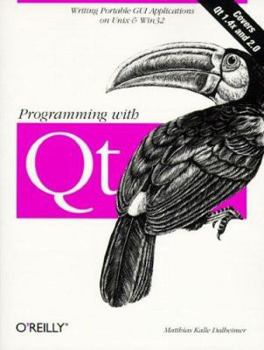Programming with QT
Qt is a C++ class library for writing GUI applications that run on UNIX, Windows 95/98, and Windows NT platforms. Qt is much easier to use than the standard Motif toolkit for UNIX systems, but at the... This description may be from another edition of this product.
Format:Paperback
Language:English
ISBN:1565925882
ISBN13:9781565925885
Release Date:April 1999
Publisher:O'Reilly Media
Length:380 Pages
Weight:1.40 lbs.
Dimensions:0.8" x 7.1" x 9.2"
Customer Reviews
5 ratings
Good addition, but short on pithy examples
Published by Thriftbooks.com User , 23 years ago
This is indeed a very good book but it can't compete with Solin's "Qt Programming" (published by Sams) as an introduction (at least not in it's present 1st edition..perhaps the soon to be published 2nd edition will be such an improvement that this situation will change, but I think that's unlikely). Depending on your budget and the improvements that come into edition 2, this is a worthwhile addition to any Qt programmer's bookshelf.The main weakness of the book is the shortage of succinct and simple examples that illustrate the various Qt classes and concepts. (This is where Solin, on the other hand excels). There is one hefty example (Qtscribble) that is presented in various versions in the chapters 2 and 3. The rest of the book presents only code snippets and (worthwhile) discussions. Edition 1 is also quite outdated so waiting for edition 2 is very advisable.
Easy C++ GUIs with qt
Published by Thriftbooks.com User , 24 years ago
Easy reading introduction into GUI programming with qt in C++. The book focuses on qt without applying C++ exception handling or the standard template library. It also does not explain too deeply the workings behind qt's callback system, but just, how to use it. After reading the book I could immediately make a GUI on Linux. Earlier it took me much longer to do the same thing with Motif. The qdesigner which comes with qt2.2.0 takes away a lot of work. The book also explaines other capabilities of qt than the GUI main topic (e.g. socket handling class, qt container classes, etc.). The help pages of the new qdesigner will also help one in applying the teaching of this book.
Good book, but obsolete already
Published by Thriftbooks.com User , 25 years ago
I don't think this book is so bad as some people said below. It does what it was writen for - teaches programming Qt.I don't agree that this book doesn't contain good samle codes. While reading it I compiled and ran the most of examples.The problem with the book is that it's based on the obsolete version of Qt (1.4x, current is 2.02), so some classes and functions have changed a bit.Reading the Qt mailing list I noticed that many people who start reading fail to compile the very 1st example "Hello, World"at p.13, because now QLabel constructor has different arguments. But the book has errata page in the Internet, you may check it.In any case right now it's the only Qt book. Troll Tech people are still preparing their own (Qt: The Officiak Documentation).
Good intro to Qt programming.
Published by Thriftbooks.com User , 25 years ago
I enjoyed this book thoroughly. I'm not sure what the other reviewers are talking about when they say that the book was riddled with errors; I didn't notice any (I suppose if there were any, they were easily fixed), and had absolutely no problems getting the code to compile. Qt is a great toolkit, and this is an excellent introduction. The only thing I would have changed about this book is to make every chapter have some exercises instead of only the first few chapters.
Good tutorial and overview - a necessary and welcome book
Published by Thriftbooks.com User , 25 years ago
First, I'm not exactly a GUI hacker, so you'll have to bear with my relative lack of knowledge in this area.I do believe that Qt is mostly that: 'Cute'. It also is an excellent candidate for 'easy' GUI programming. What I wanted to find out among other things was whether Qt is a potential industrial strength full replacement of either Motif or the Windows API or both.Unfortunately, Matthias' book falls a little short of the answer, being too loyal to Qt to point out any shortcomings. It rightfully, if drily and repetitively, points out why Qt might be better or more suitable for easy-to-write (relatively speaking) and somewhat portable GUI-based applications.The book faithfully takes you through all the details of the tutorials which are arranged in suitably increasing difficulty. In the last few chapters it also discusses version 2.0 of Qt (yet to be released), the Perl interface and the available GUI builders.The book isn't designed as a reference manual, so you will have to stick with the Qt online reference. The tone of the book is rather dry and occasionally repetitive, which works somewhat like your favorite Latin teacher.What's missing? A discussion of Qt's features compared to established GUIs (in particular customization and 'Desktop' issues), a stronger connection to the KDE project (after all, it _is_ possible to write a Window Manager using Qt, so what did that take?) and maybe a little more casual tone or even humor.






